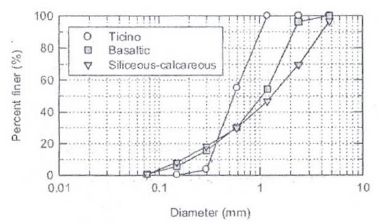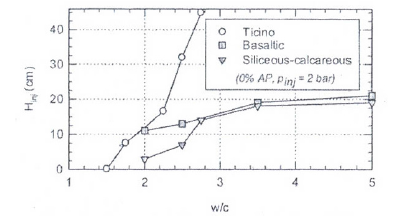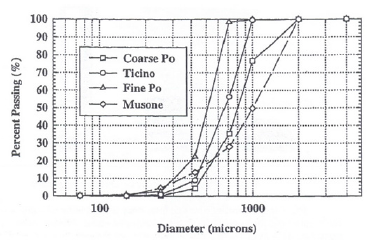- Submissions

Full Text
Environmental Analysis & Ecology Studies
The Influence of Uniformity Coefficient and Degree of Soil Saturation on the Injectability of Cement Suspensions - A Mini Review
Christodoulou Dimitrios*
Department of Environmental Sciences, University of Thessaly, Greece
*Corresponding author: Christodoulou Dimitrios, Department of Environmental Sciences, University of Thessaly, Greece
Submission: January 11, 2023; Published: January 25, 2023

ISSN 2578-0336 Volume10 Issue3
Abstract
The improvement of the mechanical properties of soils can be attained by the execution of an appropriate injection program. The injection materials that are used for that purpose, called grouts, may be either suspensions of solid particles in water or chemical solutions. Cement suspensions penetrate satisfyingly into coarse sands, whereas chemical solutions penetrate satisfyingly into finer formations, such as fine sands or silty soils. Over the last years, efforts have been made for the evolution of microfine cements suspensions, in order to replace the chemical solutions, which are thought to be toxic and harmful for the environment and the human. In this work, the effect of soil parameters such as uniformity coefficient and degree of saturation on the injectability of cement suspensions is evaluated.
Keywords:Permeation grouting; Cement suspension; Uniformity coefficient; Saturation degree
Introduction
The initial stage of a comprehensive investigation of soil improvement with suspension injections consists of a series of tests to determine suspension properties. Suspension grouts are the most economical solution, but at the same time they show many important disadvantages such as the inability to develop endurance and the difficulty of penetration. The most popular suspension type grouts are those based on cement, which have Portland cement and water as their main components. Depending on the needs of each application (high initial strength, resistance to chemical environment) it is possible to use different types of cement (aluminum, slag, etc.) instead of common cement. In addition, it is possible to add to the grouts some solids (sand, clay) with the main purpose of reducing the cost of injections, while the use of admixtures such as fly ash, slag and silica fume and the addition of chemical improvers (superplasticizers, water reducers, coagulation accelerators etc.) aims to improve some properties. Since then, several research efforts have been made towards documenting environmentally friendly materials with an emphasis on improving the properties of cement suspensions such as bleeding and durability [1-8]. Soil is one of the most important and at the same time most complex factors affecting the injectability of cement-based suspensions. The main characteristics of the soil, which affect the injection process, are: the size of the sand grains, the percentage of fine components (<75μm) and the granulometric gradation (uniformity coefficient). The specificity of soil formations lies, mainly, in the difficulty of isolating one of the aforementioned factors and evaluating the effect it exerts on injectivity.
The research of injectability is mainly based on one-dimensional laboratory injections using large length columns that resemble more accurate the injection process in the field. Empirical criterions and arithmetical and analytical methods have been developed for the estimation of injectability. The available criterions are exclusively based on the characteristic size of both cement and soil particles, and they do not take into consideration other factors that may affect injectability, such as water to cement ratio and the use of additives and admixtures. Therefore, many researchers consider them as insufficient and it is believed that these criterions tend to overestimate injectability of cement suspensions. It is concluded from the laboratory results that a decrease in the cement particle size and an increase in the water to cement ratio can improve significantly injectability. Opposite results may be obtained either by increasing sand fineness and co-efficient of uniformity of soil or due to the existence of a small percentage of fines. The addition of additives and admixtures seems to affect injectability beneficially, whereas the effect of the injection pressure appears to be less significant.
The Effect of the Uniformity Coefficient on the Injectability of Cement Suspensions
The effect of grain size distribution (uniformity coefficient) of the porous medium on injectability and permeability was thoroughly investigated by Santagata [9]. Specifically, a series of laboratory impregnations was performed using a fine-grained cement and water-to-cement ratios ranging from 1.5:1 to 2.75:1. Injectability was investigated in the laboratory using three sands: a uniform Ticino quartz sand with Cu=2 and two less uniform sands with Cu=6.5 and Cu=10.6 respectively. The grain size grading of the three sands is shown in Figure 1 below. Injection results carried out on the three sands are shown in Figure 2. The conclusion drawn is that the column packed with the uniform Ticino sand was fully impregnated for a water-to-cement ratio of 2.75:1, while for the same water-to-cement ratio the penetration lengths in the columns containing the two other less uniform sands did not exceed 15cm.
Figure 1: Grain size distribution of the three sands [9].

Figure 2: Penetration length of fine cement suspensions in the three different sands [9].

Santagata [10] also carried out laboratory injections in four sands of different grain size. Three fine-grained cements (P-Z-9, P-Z- 17, P-Z-20) were the basis for the preparation of the suspensions used to carry out the impregnations. The granulometric gradation of the four available sands (Coarse Po, Ticino, Fine Po, Musone) is illustrated in Figure 3. Table 1 lists the uniformity coefficients of the four sands. The results obtained are not consistent with the observations of Santagata [9] mentioned in the previous paragraph. In particular, the suspensions of the P-Z-9 and P-Z-17 cements penetrated all four sands, in contrast to the suspensions of P-Z- 20, which did not permeate the Fine Po and Musone sands. This finding confirms the impossibility of distinguishing the effect that each factor has on injectability. This is evidenced by the fact that the Fine Po sand (although more uniform) was not impregnated, while the Coarse Po (less uniform) was completely impregnated by all suspensions of fine cements. The inconsistency of observations resulting from the aforementioned research efforts indicates that the uniformity factor is probably not the most important factor influencing injectivity. However, its combination with the fineness of the soil formation has a significant impact on the success of a testing program.
Figure 3:Gradation of the four sands [10].

Table 1:Uniformity coefficients of the four available sands [10].

The Effect of Degree of Sand Saturation on the Injectability of Cement Suspensions
Experimental tests investigating the effect of degree of saturation on potentiation were carried out by Perret et al. [11], who used a fine-grained cement and a Type III common cement at water-tocement ratios of 0.5:1, 0.6:1, 1.2:1, and 2:1. The sand impregnated was fine Ottawa sand. Regardless of the type of cement and sand, it was observed that the sand column was more difficult to soak in the case of full saturation than the sand column, which contained 10% water. The authors attribute the difficulty encountered by the grout in penetrating to the fact that the saturation of the sand blocked the fine pores and consequently led to the reduction of the porosity of the medium. The European Standard NF P18-891 (1986) provides for injectability tests on both saturated sands and sands in the dry state. Typically, injection in dry sand is more difficult than in saturated sand due to the absorption of grout water, which reduces its flow. It is assumed that there is an optimum percentage of water, which is linked to the grain size and relative density of the sand under consideration.
Discussion
Based on the available literature, the following conclusions can
be advanced:
A. The main characteristics of the soil, which affect the
injection process, are the size of the sand grains, the percentage
of fine components (<75μm) and the granulometric gradation
(uniformity coefficient). The specificity of soil formations lies,
mainly, in the difficulty of isolating one of the aforementioned
factors and evaluating the effect it exerts on injectability.
B. The increase in the fineness of the soil and the degree of
compaction as well as the presence of fine components inhibit
the injection process and contribute to the reduction of the
penetration radius.
C. The uniformity factor is probably not the most important
factor influencing injectability. However, its combination with
the fineness of the soil formation has a significant impact on the
success of a testing program.
D. Injection in dry sand is more difficult than in saturated
sand due to the absorption of grout water, which reduces its
flow. It is assumed that there is an optimum percentage of
water, which is linked to the grain size and relative density of
the sand under consideration.
References
- Christodoulou DN, Droudakis AI, Pantazopoulos IA, Markou IN, Atmatzidis DK (2009) Groutability and effectiveness of microfine cement grouts. In: Hamza M (Ed.), Proceeding of the 17th International Conference on Soil Mechanics and Geotechnical Engineering, The Academia and Practice of Geotechnical Engineering, Alexandria, Egypt, IOS Press 3: 2232-2235.
- Christodoulou DN (2009) Groutability ratios’ investigation and improvement of suspensions for soil grouting, Ph.D. Thesis, Department of Civil Engineering, Democritus University of Thrace, Xanthi, Greece, pp. 1-370.
- Pantazopoulos IA, Markou IN, Christodoulou DN, Droudakis AI, Atmatzidis DK, et al. (2012) Development of microfine cement grouts by pulverizing ordinary cements. Cement and Concrete Composites 34(5): 593-603.
- Markou IN, Christodoulou DN, Petala ES, Atmatzidis DK (2018) Injectability of microfine cement grouts into limestone sands with different gradations: Experimental investigation and prediction. Geotechnical and Geological Engineering Journal 36(2): 959-981.
- Markou IN, Christodoulou DN, Papadopoulos BK (2015) Penetrability of microfine cement grouts: Experimental investigation and fuzzy regression modeling. Canadian Geotechnical Journal 52(7): 868-882.
- Christodoulou D, Lokkas Ph, Markou I, Droudakis A, Chouliaras I, et al. (2021) Principles and developments in soil grouting: A historical review. WSEAS Transactions on Advances in Engineering Education 18: 175-191.
- Christodoulou D, Lokkas Ph, Droudakis A, Spiliotis X, Kasiteropoulou D, et al. (2021) The development of practice in permeation grouting by using fine-grained cement suspensions. Asian Journal of Engineering and Technology 9(6): 92-101.
- Markou IN, Kakavias K, Christodoulou DN, Toumpanou I, Atmatzidis DK (2020) Prediction of cement suspension grout ability based on sand hydraulic conductivity. Soils and Foundations 60(4): 825-839.
- Santagata MC, Santagata E (2003) Experimental investigation of factors affecting the injectability of microcement grouts. In: Johnsen FL, Bruce AD, Byle JM (Eds.), 3rd International Conference on Grouting and Ground Treatment, Geotechnical Special Publication, New Orleans, USA, pp. 1221-1234.
- Santagata MC, Collepardi M (1998) Selection of cement-based grouts for soil treatment. In: Johnsen L, Berry D (Eds.), Proceedings of Sessions of Geo-Congress 98, Geotechnical Special Publication, Boston, Massachusetts, USA, pp. 177-195.
- Perret S, Ballivy G, Khayat K, Mnif T (1997) Injectability of fine sand with cement-based grout. In: Vipulanandan C (Ed.), Proceedings, Conference on Grouting: Compaction, Remediation, Testing, Geotechnical Special Publication, Logan, Utah, USA, pp. 289-305.
© 2023 © Christodoulou Dimitrios. This is an open access article distributed under the terms of the Creative Commons Attribution License , which permits unrestricted use, distribution, and build upon your work non-commercially.
 a Creative Commons Attribution 4.0 International License. Based on a work at www.crimsonpublishers.com.
Best viewed in
a Creative Commons Attribution 4.0 International License. Based on a work at www.crimsonpublishers.com.
Best viewed in 







.jpg)






























 Editorial Board Registrations
Editorial Board Registrations Submit your Article
Submit your Article Refer a Friend
Refer a Friend Advertise With Us
Advertise With Us
.jpg)






.jpg)














.bmp)
.jpg)
.png)
.jpg)










.jpg)






.png)

.png)



.png)






